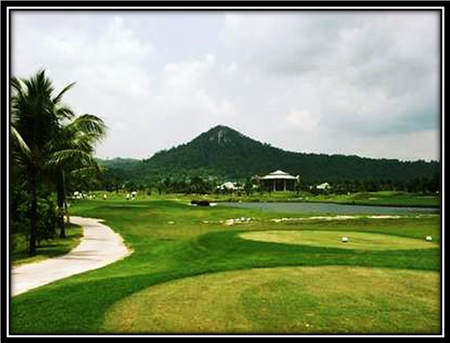Welcome to Golfnutter’s Blog – a weekly commentary highlighting contemporary golfing issues, in Pattaya and beyond. For more on matters golf, especially Pattaya golf, visit www.golfnutter.wordpress.com.
Imagine your IPGC/PSC affiliated group is enjoying its day out at Khao Kheow. Your four-ball is on the tee of C9 – the par-4 pictured in the photo. The player whose card you are marking has just sent his tee-shot into what looks like a large bunker, located some 200 yards down the right, between the fairway and the lake.
 C9 from the tee-box at Khao Kheow.
C9 from the tee-box at Khao Kheow.
Having managed to keep your tee-shot on the short stuff, you head off to where you suspect your partner’s ball will be. On the way you read the Local Rules printed on the scorecard. There are two salient points:
- Embedded ball rule is in effect through the green.
- The waste bunkers, the sand areas, on the right side of holes 2a, 9a, 5c & 9c and left side of 3a, 2b & 7c are neither bunkers nor hazards. These 7 areas all contain grassy bushes.
On arrival you note the ball is in the “waste bunker”. You also note that less than half is visible as it’s embedded in sand. You realise the scorecard’s reference to “Embedded ball rule” refers to Rule 25-2 – relief, without penalty, for a ball embedded in its own pitch-mark in any closely-mown area through the green. This, however, is not a “closely-mown area”.
The player, whose card you are marking, asks for a free drop on the grounds that his ball is embedded through the green, and, according to the scorecard, is not in a hazard.
As marker, one of your most important duties is to protect the interests of every other golfer in the field – the other competitors – as indeed they should protect yours. Given all of the above, how would you respond?
Both IPGC and PSC Local Rules give relief, without penalty, for an embedded ball lying through the green (on any part of the course except for hazards, plus the tee and putting green of the hole in play). Neither makes reference to sand. This, when added to what the scorecard states, means the ball clearly lies through the green. So what’s the problem with granting the request for a free drop?
The problem is sand.
The Rules of Golf contain a section headed: Appendix 1; Local Rules; Conditions of the Competition. One purpose of this section is to ensure golf clubs apply uniformity when devising Local Rules. Another is to ensure the integrity of handicapping systems by restricting what clubs can and can’t do with Local Rules. Thus the R&A’s following instruction to local committees: If local abnormal conditions interfere with the proper playing of the game and the Committee considers it necessary to modify a Rule of Golf, authorisation from the R&A must be obtained.
Both IPGC and PSC Local Rules contain instances where the Rules of Golf have been modified, without R&A sanction, and understandably so given the uniqueness that is golf in Thailand. But when it comes to modifying a Rule of Golf, where the playing circumstances are the same here as anywhere else in the world, I believe R&A instruction should be followed.
The rule makers never intended that relief be given for a ball embedded in sand, if that sand is not within a closely-mown area: Appendix 1, Part B, Specimen Local Rules 4.a. Relief for Embedded Ball:
When permission to take relief for an embedded ball anywhere through the green would be warranted, the following Local Rule is recommended:
“Through the green, a ball that is embedded in its own pitch-mark in the ground may be lifted, without penalty, cleaned and dropped as near as possible to where it lay but not nearer the hole. The ball when dropped must first strike a part of the course through the green.
Exceptions:
1. A player may not take relief under this Local Rule if the ball is embedded in sand in an area that is not closely mown.
Note: “Closely-mown area” means any area of the course, including paths through the rough, cut to fairway height or less.
This clearly excludes sand from the condition under which relief is provided. Unless found on the putting surface, sand is not a loose impediment. It cannot be moved, removed, shaped, or played with in any way. If a ball comes to rest in sand, the Rules intend that it be played as it lies.
We need to recognise the relevance of sand when considering relief for an embedded ball. Khao Kheow has seven of these waste bunkers, so the chance of them catching someone’s ball is high.
I believe the golfer is not entitled to relief without penalty, as his ball is embedded in sand that is not within a closely-mown area.
Happy Golfing,
Golfnutter




